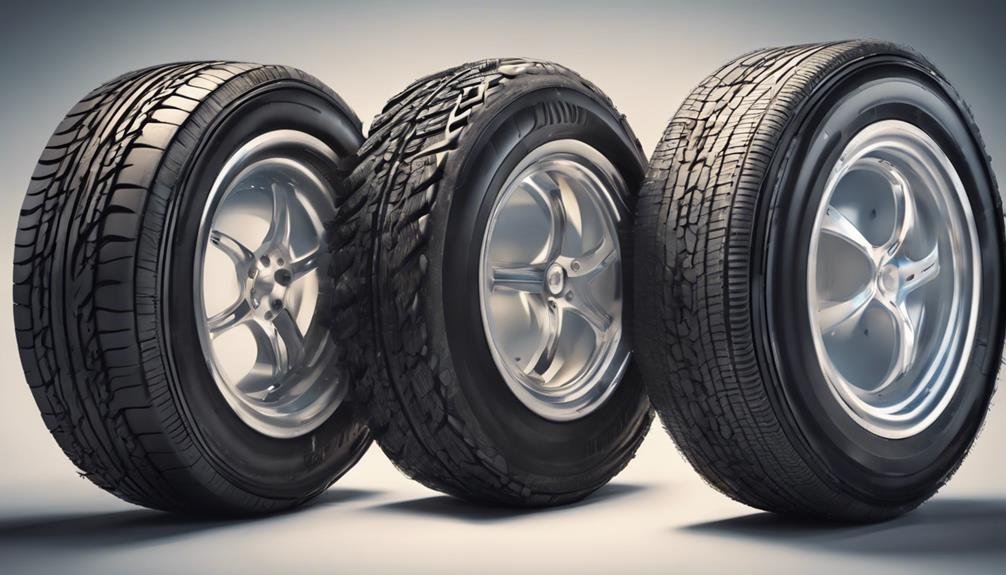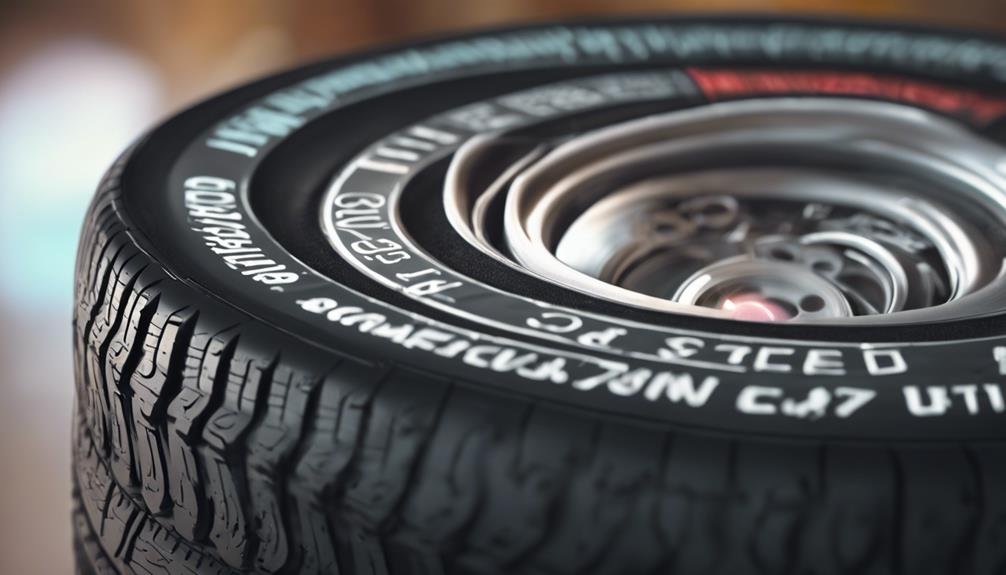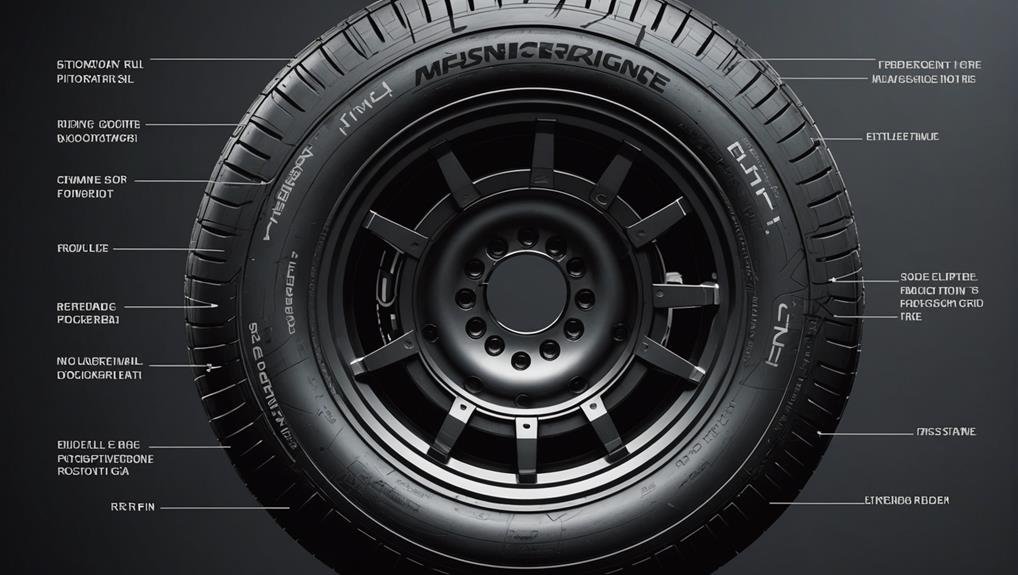When you're shopping for new tires, understanding the complex code on the sidewall is important. The code breaks down into components: tire width, aspect ratio, construction type, load index, and speed rating. Width affects handling and fuel efficiency, while aspect ratio impacts ride quality. Construction type influences traction and ride comfort, and load index determines weight capacity. Speed rating guarantees safe speed limits. With so many variables, selecting the right tire size can be challenging. But by grasping these components and considering factors like rim diameter and vehicle performance, you'll be well-equipped to make an informed decision – and there's more to discover.
Key Takeaways
- Understand the tire size code breakdown, including the starting letter, width, aspect ratio, and construction type, to ensure proper tire selection.
- Consider the impact of construction types (radial vs. bias) and rim diameter on ride quality, traction, and wheel compatibility.
- Match the load index and speed rating of replacement tires to the originals to maintain consistent performance and safety.
- Select the appropriate tire size based on vehicle type, considering factors such as tire width, aspect ratio, and wheel diameter.
- Consult tire experts and authorized retailers to avoid common mistakes and ensure proper tire size selection for optimal performance, handling, and safety.
Understanding Tire Size Codes
When you're shopping for new tires, one of the initial things you'll notice is the mysterious code on the sidewall, which can be deciphered to reveal valuable information about the tire's size and capabilities. This code, known as the tire size code, contains crucial tire size information that affects your vehicle's performance and compatibility.
The code typically starts with a letter indicating the tire type, such as P for passenger vehicles, LT for light trucks, or ST for special trailers. The next three digits represent the tire's width in millimeters, which impacts performance and compatibility.
The aspect ratio, represented by a two-digit number after the slash, shows the sidewall height relative to the width, influencing handling. The construction type, denoted by a letter such as R for radial, signifies the tire's internal layers' orientation, affecting ride quality and traction.
Ultimately, the wheel diameter, specified by the last number in the code, determines the size of the wheel the tire fits and influences handling and performance.
Decoding Tire Width and Aspect Ratio
As you delve into the world of tire sizes, understanding the intricacies of tire width and aspect ratio becomes important in making an informed decision for your vehicle.
The tire width, measured in millimeters, is represented by the initial three digits in the tire size, such as 215 in P215/65 R15. This width affects the handling and comfort of your vehicle, with a wider tire typically providing better grip and handling.
The aspect ratio, indicated by the two-digit number after the slash, shows the sidewall height as a percentage of the tire width. A larger aspect ratio means a taller sidewall, impacting the handling and comfort of the tire. For example, a 65 aspect ratio means the sidewall height is 65% of the tire width.
A radial construction type, denoted by the letter R, signifies a tire with layers running across the tire for better traction and performance. Understanding these components is vital in selecting the right tire for your vehicle, as they have a significant impact on the overall performance, handling, and comfort of your vehicle.
Construction Types and Rim Diameter

Your tire's construction type and rim diameter play a crucial role in determining its performance, handling, and compatibility with your vehicle, making it essential to understand the differences between radial and bias constructions, as well as the significance of the rim diameter specified in the tire size.
When reading tire sizes, you'll notice a letter indicating the construction type, either 'R' for radial or 'D' for bias. Radial construction, found in most modern vehicles, means the tire's layers run across it, providing a smoother ride and better traction. On the other hand, bias-constructed tires have plies that crisscross at an angle, offering stiffer sidewalls and more stability in certain applications. Understanding the construction type is vital for selecting tires that suit your driving needs and vehicle requirements.
The rim diameter, specified in inches, indicates the size of the wheel the tire fits, affecting handling, performance, and compatibility. For instance, a tire size with a 15'' rim diameter is designed for a wheel of that size. When choosing tires, make sure the rim diameter matches your vehicle's wheel size to guarantee proper fit and excellent performance.
Load Index and Speed Rating Explained
Now that you've got a handle on construction types and rim diameter, it's time to unravel the mysteries of load index and speed rating, two critical components that directly impact your safety on the road.
The load index, a numerical value, indicates the maximum weight a tire can support, with higher numbers representing a higher weight capacity. It's important to match the load index of your replacement tires to the originals to guarantee consistent performance and safety.
The speed rating, denoted by a letter, signifies the maximum speed a tire can safely handle. Always adhere to legal speed limits, regardless of the tire's speed rating, to promote safe driving practices.
When selecting tires, consult your vehicle's manual or a tire professional to determine the right load index and speed rating for your vehicle. Remember, matching replacement tires to the originals is vital for consistent performance and safety.
Tire Size Variations and Options

When shopping for tires, you'll encounter different size types, each catering to specific vehicle types and applications. Understanding these variations is important to selecting the right tires for your vehicle. There are three main types of tire sizes: metric, flotation, and numeric.
| Tire Size Type | Vehicle Type | Measurement |
|---|---|---|
| Metric | Passenger vehicles | Three sets of numbers, with potential letters like P, LT, or R |
| Flotation | Trailers, tractors, ATVs | Inches for tire height, width, and wheel diameter |
| Numeric | Light trucks, commercial vehicles | Two or three sets of numbers indicating tire width, height, and wheel diameter in inches |
Metric sizing is the most common type, used for passenger vehicles, while flotation sizing is commonly used for trailers and ATVs. Numeric sizing is prevalent in light trucks and commercial vehicles. By recognizing these variations, you can choose the appropriate tire size for your specific vehicle and purpose. This helps ensure performance, safety, and fuel efficiency.
Severe Snow Conditions and Tire Markings
As you navigate through different tire sizes, it's just as important to take note of the markings on your tires, especially when driving in severe snow conditions.
One key marking to look for is the M+S symbol, which indicates that your tires are suitable for mud and snow conditions. The M+S marking is a guarantee that your tires are designed to provide improved traction in challenging winter weather, making them the appropriate choice for driving in snowy or muddy environments.
Tires with the M+S designation are engineered to perform better in snow and mud compared to standard tires, ensuring you have better control on the road.
When selecting tires for driving in severe snow conditions, make sure to check for the M+S symbol, as it's an important indicator of a tire's ability to handle winter weather.
By choosing tires with the M+S marking, you'll have the traction and control you need to navigate through challenging conditions safely.
Tire Identification and Certification

Your tire's sidewall holds the key to understanding its identity, with a unique combination of numbers and letters that reveal its size, type, and certification.
These markings are important in determining the correct tire size for your vehicle, as they indicate the tire's width, aspect ratio, and wheel diameter. For instance, a tire size like 225/60R18 breaks down to a width of 225 millimeters, an aspect ratio of 60, and a wheel diameter of 18 inches.
Understanding tire size types, such as metric sizing for passenger vehicles and flotation sizing for trailers, is essential in selecting the right tire for your vehicle. When in doubt, consulting an authorized tire retailer can help you get the correct tire specifications for your vehicle. They can assist you in navigating size substitutions and guarantee a proper fit.
Choosing the Right Tire Size
By considering factors like vehicle make, model, and driving habits, you can narrow down the ideal tire size that meets your specific needs and guarantees peak performance. This is important, as the right tire size impacts vehicle performance, handling, and safety on the road.
To guarantee compatibility with your vehicle's recommended specifications, you should consider the following key factors:
- Tire Width and Aspect Ratio: These measurements affect your vehicle's overall performance, handling, and safety.
- Wheel Diameter: Ensuring the correct wheel diameter is essential for maintaining consistent speed ratings and load indexes.
- Consulting Tire Experts: If you're unsure, seeking advice from tire experts can provide guidance on selecting the appropriate tire size for your vehicle.
Common Tire Size Mistakes to Avoid

When selecting new tires, beware of common mistakes that can compromise your vehicle's performance and safety. One mistake is relying solely on the tire size listed in your owner's manual, especially if the tires have been changed. This may not reflect the current tire size, leading to issues like rubbing, steering wheel pull, reduced clearance, or a stiffer ride.
Another mistake is neglecting to take into account load index and speed rating when choosing new tires. Make sure to match or exceed the requirements of the original tires to guarantee proper performance and safety. Consult an authorized tire retailer for size substitutions to ensure proper fitment and performance.
Understanding tire size measurements and specifications is essential to avoid common mistakes when selecting or replacing tires. By being mindful of these potential pitfalls, you can ensure a smooth and safe ride. Remember, selecting the right tire size is vital, and consulting a tire retailer can help you make an informed decision.
Frequently Asked Questions
How to Understand Tire Sizes?
You're wondering how to understand tire sizes? Start by recognizing that tire sizes consist of three numbers, representing width, aspect ratio, and wheel diameter – breaking it down makes it easier to choose the right tires for your ride.
What Does 225 65R17 Mean?
You're wondering what "225 65R17" means? It's a tire size! The "225" refers to the width in millimeters, "65" is the aspect ratio, "R" indicates radial construction, and "17" is the wheel diameter in inches.
What Does 265 50R20 Mean on a Tire?
You're looking at a tire size of 265 50R20, which means you've got a tire that's 265mm wide, with a 50% aspect ratio, radial construction, and designed to fit a 20-inch wheel.
What Do the Three Numbers Mean on Tire Size?
When you see three numbers on a tire size, you're looking at the width, aspect ratio, and wheel diameter. You're checking the tire's width in millimeters, its height as a percentage of width, and the wheel size in inches it fits.
Conclusion
Now that you've grasped the intricacies of tire sizes, you're better equipped to make informed decisions when it's time to replace your tires.
Remember, the correct tire size can greatly impact your vehicle's performance, safety, and fuel efficiency.
By accurately decoding tire size codes, considering load index and speed ratings, and evaluating construction types, you'll guarantee a smooth ride and peak vehicle performance.
